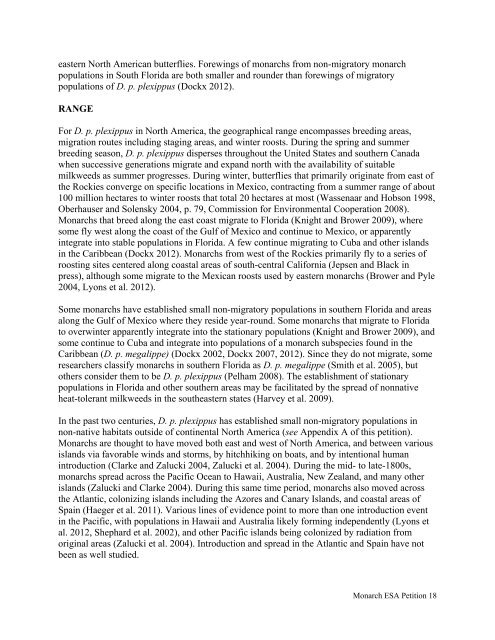monarch-esa-petition-final_61585
monarch-esa-petition-final_61585
monarch-esa-petition-final_61585
You also want an ePaper? Increase the reach of your titles
YUMPU automatically turns print PDFs into web optimized ePapers that Google loves.
eastern North American butterflies. Forewings of <strong>monarch</strong>s from non-migratory <strong>monarch</strong><br />
populations in South Florida are both smaller and rounder than forewings of migratory<br />
populations of D. p. plexippus (Dockx 2012).<br />
RANGE<br />
For D. p. plexippus in North America, the geographical range encompasses breeding areas,<br />
migration routes including staging areas, and winter roosts. During the spring and summer<br />
breeding season, D. p. plexippus disperses throughout the United States and southern Canada<br />
when successive generations migrate and expand north with the availability of suitable<br />
milkweeds as summer progresses. During winter, butterflies that primarily originate from east of<br />
the Rockies converge on specific locations in Mexico, contracting from a summer range of about<br />
100 million hectares to winter roosts that total 20 hectares at most (Wassenaar and Hobson 1998,<br />
Oberhauser and Solensky 2004, p. 79, Commission for Environmental Cooperation 2008).<br />
Monarchs that breed along the east coast migrate to Florida (Knight and Brower 2009), where<br />
some fly west along the coast of the Gulf of Mexico and continue to Mexico, or apparently<br />
integrate into stable populations in Florida. A few continue migrating to Cuba and other islands<br />
in the Caribbean (Dockx 2012). Monarchs from west of the Rockies primarily fly to a series of<br />
roosting sites centered along coastal areas of south-central California (Jepsen and Black in<br />
press), although some migrate to the Mexican roosts used by eastern <strong>monarch</strong>s (Brower and Pyle<br />
2004, Lyons et al. 2012).<br />
Some <strong>monarch</strong>s have established small non-migratory populations in southern Florida and areas<br />
along the Gulf of Mexico where they reside year-round. Some <strong>monarch</strong>s that migrate to Florida<br />
to overwinter apparently integrate into the stationary populations (Knight and Brower 2009), and<br />
some continue to Cuba and integrate into populations of a <strong>monarch</strong> subspecies found in the<br />
Caribbean (D. p. megalippe) (Dockx 2002, Dockx 2007, 2012). Since they do not migrate, some<br />
researchers classify <strong>monarch</strong>s in southern Florida as D. p. megalippe (Smith et al. 2005), but<br />
others consider them to be D. p. plexippus (Pelham 2008). The establishment of stationary<br />
populations in Florida and other southern areas may be facilitated by the spread of nonnative<br />
heat-tolerant milkweeds in the southeastern states (Harvey et al. 2009).<br />
In the past two centuries, D. p. plexippus has established small non-migratory populations in<br />
non-native habitats outside of continental North America (see Appendix A of this <strong>petition</strong>).<br />
Monarchs are thought to have moved both east and west of North America, and between various<br />
islands via favorable winds and storms, by hitchhiking on boats, and by intentional human<br />
introduction (Clarke and Zalucki 2004, Zalucki et al. 2004). During the mid- to late-1800s,<br />
<strong>monarch</strong>s spread across the Pacific Ocean to Hawaii, Australia, New Zealand, and many other<br />
islands (Zalucki and Clarke 2004). During this same time period, <strong>monarch</strong>s also moved across<br />
the Atlantic, colonizing islands including the Azores and Canary Islands, and coastal areas of<br />
Spain (Haeger et al. 2011). Various lines of evidence point to more than one introduction event<br />
in the Pacific, with populations in Hawaii and Australia likely forming independently (Lyons et<br />
al. 2012, Shephard et al. 2002), and other Pacific islands being colonized by radiation from<br />
original areas (Zalucki et al. 2004). Introduction and spread in the Atlantic and Spain have not<br />
been as well studied.<br />
Monarch ESA Petition 18




